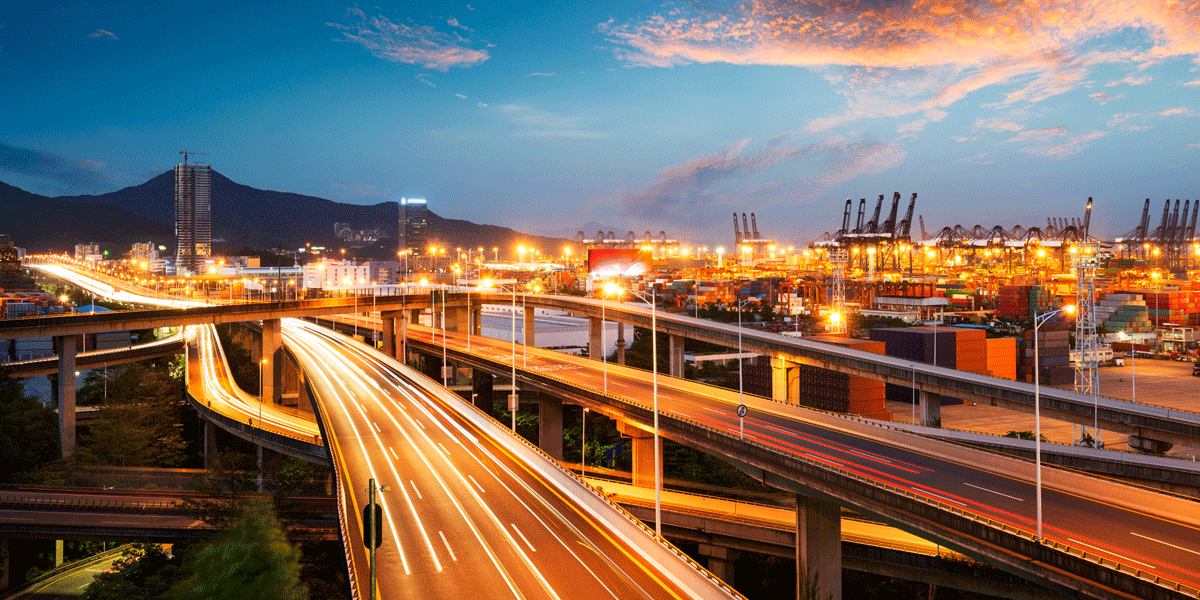The Transportation Market Today: Navigating Market Shifts
Paul has spent nearly two decades in the transportation industry with roles in finance, operations, business transformation and risk management for companies with offerings in specialized flatbed, vans, brokerage, less-than-truckload (LTL), bulk, leasing, international and intermodal operations. He joined ATS in 2014 and serves as the chief financial officer.
You’ve heard plenty of advice about how to make more money in a tough market, but what about understanding what causes the market to fluctuate and contribute to your pay?
The transportation industry is no stranger to change, but the past few years have been particularly turbulent. From the disruptive waves of the COVID-19 pandemic to the current economic slowdown, understanding the forces shaping the market is crucial for anyone involved in freight and logistics.
As we navigate 2024, it's important to reflect on the journey we've been on, recognize the current landscape, and anticipate the road ahead.
In this article, we’ll explore how consumer spending shifts during the pandemic caused dramatic swings in freight demand, examine the impact of broader economic conditions on transportation rates, and consider the potential influences that could shape the industry’s future.
Whether you’re a seasoned driver or brand-new to the industry, staying informed about these dynamics will equip you to steer through these uncertain times with confidence and foresight.
Looking Back to 2020
The COVID-19 pandemic brought unprecedented changes to our lives, drastically altering how we lived, worked, and spent money. When we think about what the market is today, we think about when the COVID-19 pandemic hit in 2020 and saw consumers locked away at home, insulated, and unable to enjoy normal activities like traveling, staying at hotels, and enjoying restaurants.
Typically, about two-thirds of consumer spend goes toward services and the remainder goes to durable goods that travel on a truck. However, the pandemic reversed this trend as people redirected their spending towards home-related purchases.
When a majority of us were at home in isolation, we couldn’t spend money on services, so we shifted our spending to durable goods. Those who could afford it started outfitting their home offices, renovating their homes, or buying things they could use while in isolation.
This surge in demand for durable goods, which are transported by trucks, led to a spike in freight movement. However, the supply of drivers couldn't keep up, causing freight rates to soar.
Post-COVID Adjustments: Returning to Normalcy
As we moved past the peak of the pandemic, consumer spending patterns began to normalize. People started dining out, traveling, and enjoying other services again.
Consequently, the demand for durable goods transportation decreased, leading to a correction in the freight market. Rates came screaming down and we were pushed into a down market. Although it may seem like a significant downturn, it's merely a return to pre-pandemic levels.
In 2023, we saw an oversupply of trucks and drivers compared to the reduced freight demand, causing rates to drop. However, by 2024, the market began to balance out. In 2024, we’ve gotten to a place where rates are at the bottom.
The number of trucks available matched the demand for freight movement, stabilizing the rates at their lowest point. Any future economic uplift will likely lead to gradual rate increases.

Current Economic Landscape and Its Influence on Transportation
The broader economic conditions play a crucial role in shaping the transportation market. Gross Domestic Product (GDP) growth, a key indicator of economic health, has slowed from 3.4% at the end of 2023 to 1.3% in the first quarter of 2024. This slowdown suggests limited economic activity, further compounded by rising unemployment, now at 4.1%.
Given these factors, it's unlikely we'll see significant economic demand lifts in the next six to 12 months. Certain sectors, like housing and industrial production, show some resilience, but overall, the economy remains sluggish.
Key Factors Influencing the Current Economic State
The factors influencing the current economic state right now include:
- Post-pandemic spending adjustments
- Inflation
- Global conflicts
Let’s dive into each further.
Post-Pandemic Spending Adjustments
The shift from goods back to services has created a whiplash effect, with the market finding a new balance. There simply aren’t as many durable goods moving on trucks as in 2020. We’re still recovering from this.
Inflation and Its Aftermath
High demand during the pandemic drove up costs, contributing to inflation. When the cost of transportation goes up, eventually that cost is passed down to the consumer. Labor and parts shortages were also a problem during the pandemic. With increased demand and a shortage of labor, rates went up. This is another measure of inflation.
Once inflation got going in 2021 and 2022, the Federal Reserve had to act. The Fed’s response — raising interest rates to control inflation — didn’t really work at first. During the first part of 2024, however, we did see consumers start to slow their spend and slow economic growth.
Inflation is starting to cool off a bit, but it’s still high.
Global Conflicts and Supply Chain Disruptions
Global conflicts and supply chain disruptions can have a significant impact on cost. Over the last year or two, we’ve seen global conflicts break out between Russia and Ukraine and in the Middle East.
The Russia-Ukraine conflict initially caused global supply chain disruptions, leading to higher costs and contributing to inflation. There are certain products these countries produce that other countries rely on. To adapt, people either need to live without those products or they need to find a substitute from a different country.
The logistics of getting the product from another country can be costlier and that cost is passed on to the consumer.
However, over time, markets adapt, find alternative suppliers and routes, and stabilize somewhat.
Future Influences on the Economy and Transportation
The factors that we may see impact the economy soon include:
- Interest rates
- Natural disasters
- Global conflicts
- Election year uncertainty
Interest Rates
The Federal Reserve might lower interest rates to prevent a recession and stimulate the economy, potentially boosting transportation demand. Experts predict that an interest rate cut is coming in September, during the next meeting of the Fed.
Natural Disasters
Events like hurricanes, earthquakes, tornadoes, and wildfires can disrupt supply chains, causing temporary spikes in freight demand and rates.
While unfortunate, the destruction these events cause can lead to a shift in economic activity. The devastation across the country requires rebuilding. This increases the movement of freight to get materials and aid into those communities.
Global Conflicts
There’s no telling what global conflicts we may see in the future, with tension still at its height in the Middle East and between Russia and Ukraine.
As mentioned earlier, there’s an impact on supply chains throughout the world. The most readily apparent impact we can see is with the oil industry in that region. Disruptions have led to alternate paths that increase cost and security risks for ships passing through the region. The increased cost has a flowdown effect.
As global conflicts pop up in the future, we may see negative effects on the economy, such as market fluctuations and higher costs.
Election Year Uncertainty
People intuitively think that if one party gets in, we’ll have a lot of growth, and if the other gets in, growth will slow down.
As a result, election years often bring economic pauses as businesses and consumers await clarity. This hesitancy can slow down investments and spending, affecting freight demand.
For example, until businesses know which administration will be taking office, they may not make large infrastructure purchases. As a result, less freight will need to move.
After the election, it doesn’t matter which party gets control; people look at what’s happened and decide which investments they’ll move forward with. But for the year or so leading up to the election, there’s a slowdown in the economy.

Navigating the Road Ahead
The transportation market is stabilizing after the dramatic shifts caused by the COVID-19 pandemic. While rates are currently at a low point, they are poised for gradual increases as the economy recovers. Understanding these economic dynamics and potential future influences can help businesses and drivers navigate the evolving landscape.
Stay informed, stay adaptable, and be prepared for the gradual changes that lie ahead. The road to recovery may be long, but with resilience and strategic planning, success is within reach.
To stay updated on everything that’s happening in the industry and for tips to help you succeed, be sure you subscribe to the Drive4ATS Learning Center.

